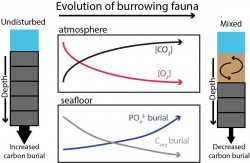Seminar: The effect of bioturbation on the cycles of carbon...

By Sebastiaan Van de Velde, MSc, PhD Researcher AMGC VUB
Today, most of the oxygenated seafloor is inhabited by fauna. These animals have a major effect on the sediment both physically (by e.g. movement) and chemically (e.g. via ingestion and defaecation of particles). Whilst the effects of burrowing on the individual elemental cycles are starting to be understood, it is still unclear what the long-term effects are for the global biogeochemical cycles.
Here we present a combination of in situ observations and diagenetic modelling results. By enhancing the oxygen uptake of the sediment, bioturbation decreases organic carbon burial while promoting phosphate retention. Furthermore, re-oxidation of reduced iron sulphides is stimulated, thereby promoting iron oxide preservation. Modelling results indicate that these effects already occur at burrowing depths of the same magnitude that were present at the beginning of the Cambrian explosion.
By inputting these present-day observations into a long-term model of the carbon, oxygen, phosphorus and sulphur cycles (COPSE), we show that the evolution of shallow burrowing in the Early Palaeozoic already had a rapid and significant environmental impact. The evolution of burrowing animals contributed to a global low-oxygen state, which prevailed for ~100 million years until the evolution of land plants caused atmospheric O2 to rise towards modern levels. This impact on global biogeochemistry of bioturbation likely also affected animal evolution through expanded ocean anoxia, high atmospheric CO2 levels and global warming.